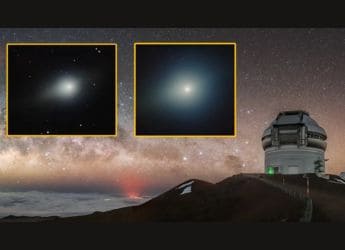- Home
- Science
- Science News
- New Findings on Universe's Dark Matter Confound Scientists
New Findings on Universe's Dark Matter Confound Scientists
Research published this week revealed an unexpected discrepancy between observations of dark matter concentrations.

Photo Credit: Yale.edu
Astrophysicist says assumption about nature of dark matter may be fundamental incorrect
Dark matter, mysterious invisible stuff that makes up most of the mass of galaxies including our own Milky Way, is confounding scientists again, with new observations of distant galaxies conflicting with the current understanding of its nature.
Research published this week revealed an unexpected discrepancy between observations of dark matter concentrations in three massive clusters of galaxies encompassing trillions of stars and theoretical computer simulations of how dark matter should be distributed.
"Either there is a missing ingredient in the simulations or we have made a fundamental incorrect assumption about the nature of dark matter," Yale University astrophysicist Priyamvada Natarajan, a co-author of the study published in the journal Science, said on Friday.
Dark matter is the invisible glue that holds stars together inside a galaxy. It also creates an invisible scaffold that enables galaxies to form clusters. But it has very peculiar properties. It does not emit, absorb or reflect light and does not interact with any known particles.
The bulk of the matter in the universe, about 96 percent, is thought to be dark matter, with ordinary matter - the visible stuff that makes up stars, planets and people - a mere 4 percent.
Dark matter's presence is known only through its gravitational pull on visible matter in space. It differs from the similarly enigmatic and unseen dark energy, which is considered a property of space and is driving the universe's accelerated expansion. Dark energy is repulsive. Dark matter attracts through gravity.
The new study involved observations from the Hubble Space Telescope and the European Southern Observatory's Very Large Telescope in Chile.
When the light from distant sources like faraway galaxies travels through matter such as another galaxy or a cluster of them, the light is deflected and bends - a phenomenon called "gravitational lensing," said astrophysicist and study lead author Massimo Meneghetti of the Observatory of Astrophysics and Space Science in Bologna and National Institute for Astrophysics in Italy.
The new observations showed that gravitational lensing effects produced by galaxies residing inside the huge galaxy clusters were far stronger than current dark matter theory envisioned, suggesting an unexpectedly large concentration of dark matter in these galaxies.
"This is quite surprising," Meneghetti said.
© Thomson Reuters 2020
Is this the end of the Samsung Galaxy Note series as we know it? We discussed this on Orbital, our weekly technology podcast, which you can subscribe to via Apple Podcasts, Google Podcasts, or RSS, download the episode, or just hit the play button below.
Get your daily dose of tech news, reviews, and insights, in under 80 characters on Gadgets 360 Turbo. Connect with fellow tech lovers on our Forum. Follow us on X, Facebook, WhatsApp, Threads and Google News for instant updates. Catch all the action on our YouTube channel.
Related Stories
- Samsung Galaxy Unpacked 2025
- ChatGPT
- Redmi Note 14 Pro+
- iPhone 16
- Apple Vision Pro
- Oneplus 12
- OnePlus Nord CE 3 Lite 5G
- iPhone 13
- Xiaomi 14 Pro
- Oppo Find N3
- Tecno Spark Go (2023)
- Realme V30
- Best Phones Under 25000
- Samsung Galaxy S24 Series
- Cryptocurrency
- iQoo 12
- Samsung Galaxy S24 Ultra
- Giottus
- Samsung Galaxy Z Flip 5
- Apple 'Scary Fast'
- Housefull 5
- GoPro Hero 12 Black Review
- Invincible Season 2
- JioGlass
- HD Ready TV
- Laptop Under 50000
- Smartwatch Under 10000
- Latest Mobile Phones
- Compare Phones
- Redmi Note 15 5G
- Redmi Note 15 Pro 5G
- Redmi Note 15 Pro+ 5G
- Lava Play Max
- Poco C85 5G
- Honor Magic 8 Lite
- Jolla Phone
- Realme P4x 5G
- Asus ProArt P16
- MacBook Pro 14-inch (M5, 2025)
- OnePlus Pad Go 2
- Poco Pad M1
- Just Corseca Skywatch Pro
- Honor Watch X5
- Acerpure Nitro Z Series 100-inch QLED TV
- Samsung 43 Inch LED Ultra HD (4K) Smart TV (UA43UE81AFULXL)
- Asus ROG Ally
- Nintendo Switch Lite
- Haier 1.6 Ton 5 Star Inverter Split AC (HSU19G-MZAID5BN-INV)
- Haier 1.6 Ton 5 Star Inverter Split AC (HSU19G-MZAIM5BN-INV)

















